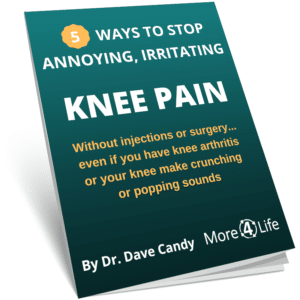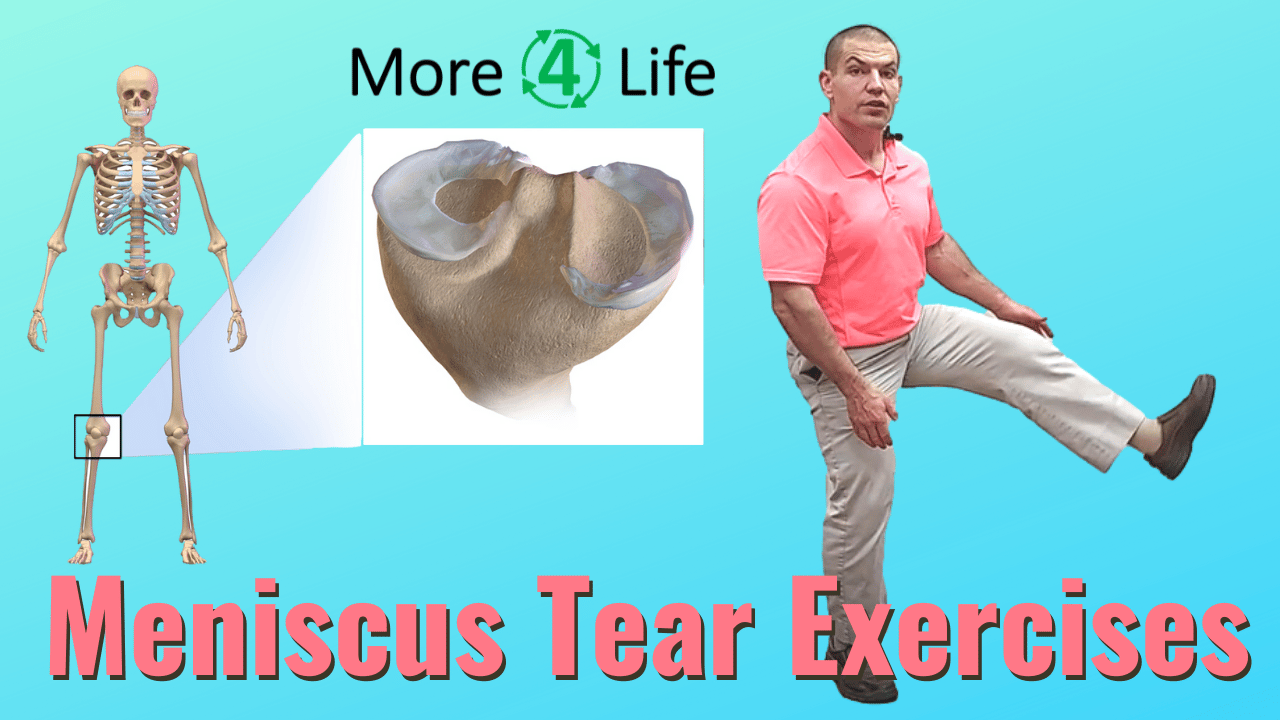What Are The Best Meniscus Tear Exercises?
Watch the video to learn which meniscus tear exercises to avoid and which exercises to do instead to help you avoid needing surgery for a torn meniscus.

Can Exercises Help A Meniscus Tear?
Before we talk about what exercises to do (and NOT to do) with a meniscus tear, it first helps to understand what the meniscus is and what happens when it's torn.
Anatomy Of The Knee Meniscus
The meniscus is found between the bottom part of the thigh bone (femur) and the top part of the lower leg bone (tibia).
The meniscus is a separate but attached structure on the inside and outside part of the knee.
It functions as a shock absorber during daily activities such as walking.
It's even more important in sports that require running or jumping.
The meniscus also helps improve the stability of the knee.
Therefore, when the meniscus is torn, it often causes symptoms of instability in the knee.
What Causes A Meniscus Tear?
The most common cause of a meniscus tear is repeated “twisting” of the knee.
When this is repeated over a long period of time, the meniscus can eventually tear.
Another cause is pivoting on the knee. Examples include cutting or changing directions when playing sports.
Another common cause of a torn meniscus is overpronating (flattening feet too much) when running or walking.
Meniscus tears can also be caused from a traumatic blow to the knee after a car accident or after a football tackle.
Is There A Test For Meniscus Tear?
Meniscus Tear MRI
The gold standard test for a meniscus tear is an MRI to see an “internal” picture of the knee.
However, there are some very good (and WAY less expensive) clinical tests for meniscus tears.
Thessaly Test For Meniscus Tear
The Thessaly test is a very specific test for a meniscus tear. That mean's a negative test won't rule out every meniscus tear. However, if the test is positive, it's very likely that you have a meniscus tear.
The test is performed in standing on the sore leg with knee slightly bent.
To do the test, you twist side-to-side on the knee.
If that motion causes instability or reproduces YOUR specific pain, it's likely that you have a meniscus tear.
Will I Need Surgery For A Meniscus Tear?
The good news is that most of the time, you do NOT need surgery for a meniscus tear.
Clinical studies show that even many people with meniscus tears on their MRI can recover just as well without surgery as with surgery.
The outer parts of the meniscus have a better blood supply than the deeper part. Therefore, sometimes tears in the deeper part of the meniscus do require surgery.
However, doing exercises that improve blood flow can help the meniscus heal without surgery.
Exercises To Avoid With A Torn Meniscus
Before discussing what exercise are good for a meniscus tear, we should first cover what exercises to avoid with a meniscus tear.
Exercises to Avoid with a Meniscus Tear include:
- High-impact Exercises
- Exercises that involve twisting
- Deep squatting
- Resisted Hamstring exercises
High-impact Exercises
As mentioned above, the meniscus acts as a shock absorber. Therefore, it will have diminished capacity to dissipate forces when it is torn.
Activities that result in increased downward forces on the meniscus will compress the thigh and lower leg bones together.
As a result, high-impact activity will increase the inflammation and can worsen a meniscus tear.
Running and jumping are prime examples of high-impact exercises to avoid with a meniscus tear.
Twisting Exercises
Also mentioned above, twisting is a major cause of meniscus tears.
Exercises that involve twisting such as golfing, tennis, swinging a baseball bat, or sports that require cutting should be avoided with a torn meniscus.
Deep Squatting
Deep squatting can also aggravate a meniscus tear.
The meniscus gets impinged at the back of the knee in a deep squat position. Heavy squatting also puts more pressure on the knee meniscus.
Squatting isn't necessarily a bad exercise if you have a meniscus tear, you just need to limit how heavy and how deep you squat.
Resisted Hamstring Exercises
One of the hamstring muscles called the semi-membranosis attaches to the back of the meniscus.
It's normal job is to pull the meniscus backward as you bend your knee to keep the meniscus in line with the joint.
However, if you already have a meniscus tear, doing heavy resisted hamstring curls can put extra tension on the meniscus.
What Meniscus Tear Exercises Are Good To Do?
Cardiovascular Exercise With Meniscus Tears?
The meniscus has the ability to repair itself, but it requires sufficient blood flow to the area to heal.
As a result, exercises that increase blood flow can help the meniscus to heal.
Just make sure to avoid high-impact cardiovascular exercises.
Good cardiovascular exercises to do with a meniscus tear include walking, swimming, and riding a stationary bike.
Running is typically not recommended due to the high-impact forces/stresses that occurs at the knee, especially within the meniscus.
Range Of Motion And Stretching Exercises For Meniscus Tear
Gentle range of motion exercises and stretches can help if you have a meniscus tear.
A gentle hamstring stretch helps you to fully straighten your knee when walking as well as allow full better blood flow in the small blood vessels (capillaries) around the knee.
Bending the knee gently while seated or riding an exercise bike are good ways to help the meniscus to glide forward and backward with the knee as it bends and straightens.
What Else Beside Exercises Can Help Meniscus Tears?
Meniscus Tear Knee Brace
A meniscus tear can cause your knee to feel unstable.
If it does wearing a hinged knee brace may be helpful.
A knee brace can help to give you more confidence to do your daily activities without fear of your knee giving out.
Shock Doctor Maximum Support Compression...
12% Off
Physical Therapy For Meniscus Tear
Although bracing and exercise can help meniscus tears, neither one address the root cause of the meniscus tear, such as poor movement patterns during daily activities or sports.
Even if the pain from a meniscus tear goes away, if you keep doing the activity that caused the meniscus tear in the first place, the meniscus tear can come back.
As the meniscus gets more and more worn down, it can put you at greater risk for knee arthritis.
Need Help For A Meniscus Tear?
If you'd like to find out which exercises to avoid for YOUR meniscus tear, plus what to do to get the pain to go away for good, tap the button below to request an appointment with one of our specialist physical therapists.





